AMD Launches Mobile Kaveri APUs
by Jarred Walton on June 4, 2014 12:01 AM ESTAMD Kaveri FX-7600P System/CPU Performance Preview
After the briefing, we were given a chance to benchmark a prototype Kaveri notebook for a few hours. That wasn't enough to run our full suite of laptop benchmarks, and battery testing in particular is something we couldn't perform. I did run some quick simulations of battery life; however, the prototype systems are optimized more for performance rather than power, so the results weren't really meaningful. We'll have to wait for retail laptops with Kaveri APUs before we can really see what sort of battery life to expect, but AMD claims there should be a decent jump in mobility compared to Richland.
The test systems were more of a proof of concept rather than anything you could actually sell. The keyboard was okay if a little mushy, but the touchpad in particular I found a bit lacking, and build quality was mediocre as well. The screens at least were good quality 1080p 15.6" touchscreen panels, and that was enough to get us benchmarking. I snapped a few pictures of the laptop that you can see above. In terms of other core specs, the laptop had 8GB of DDR3-1866 RAM and a Samsung M.2 256GB SSD.
For our purposes here, we're including the AMD Kaveri Prototype, AMD Trinity Prototype, and AMD Kabini Prototype laptops as a starting point. For retail laptops, we have the MSI GX60 with Richland A10-5750M APU (but only a single 8GB SO-DIMM, unfortunately), the Sony VAIO Pro 13 (i5-4200U), and the Acer V7-482PG (i7-4500U + GT 750M). The Acer is the only laptop equipped with a discrete GPU, so we wanted to see how Kaveri stacks up against such a system. You can compare additional results against Kaveri in Mobile Bench, of course.
Again, these numbers are only preliminary – the drivers for the GPU were slightly older (without Mantle support enabled yet), and there were occasions of odd behavior where other editors had scores that didn't match up with our results until after a reboot. We were not able to run each benchmark multiple times, so most of these results are from a single run. AMD is keen to talk about the GPU improvements with Kaveri, but I also wanted to see what has happened on the CPU side, so we'll start with our CPU/system benchmarks.
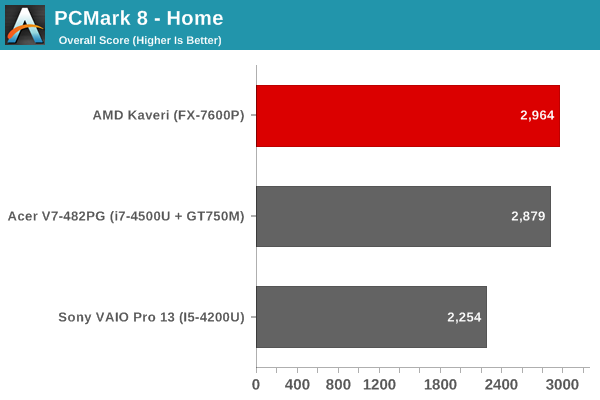
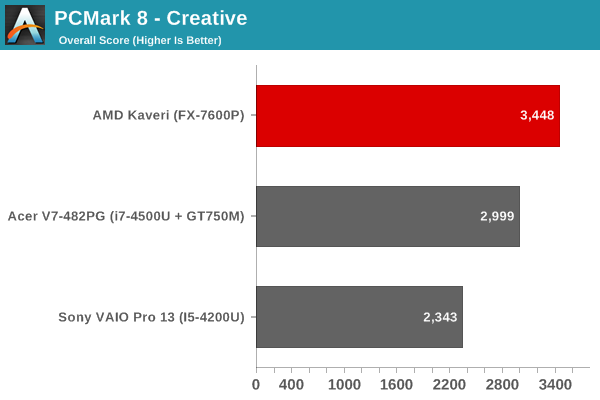

We don't have results for PCMark 8 for many of the systems, and the VAIO Pro 13 seems to be underperforming for some reason, but otherwise we get a pretty good idea of where things fall in terms of overall performance. Note that PCMark 8 is now OpenCL accelerated, which can improve performance quite a bit on AMD APUs. The result is that AMD actually takes the lead in the Home and Creative suites, but without more time benchmarking the system I wouldn't try to draw too many conclusions. Storage subsystem performance can still have an enormous impact on PCMark results, and the V7-482PG has to get by with an SSD caching solution. The VAIO Pro 13 on the other hand just seems to score a bit lower than I'd expect, so again take these scores with a grain of salt.
Moving on to other benchmarks, I also ran PCMark 7 as it doesn't have any OpenCL acceleration and will provide a better view of traditional application performance. Hopefully we'll continue to see improvements in the use of OpenCL (GPU) acceleration and over time PCMark 8 scores will be more indicative of real-world performance, but right now there are plenty of situations where having a GPU does very little for performance.

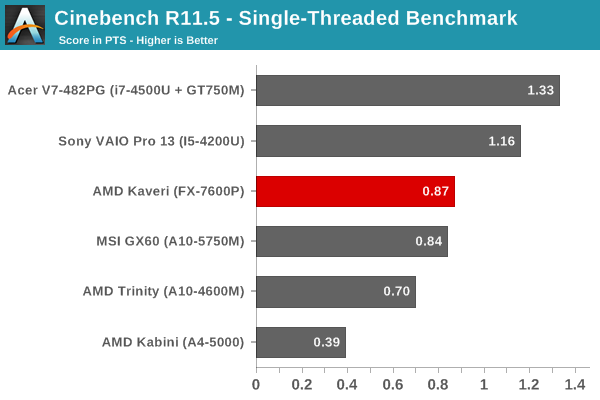
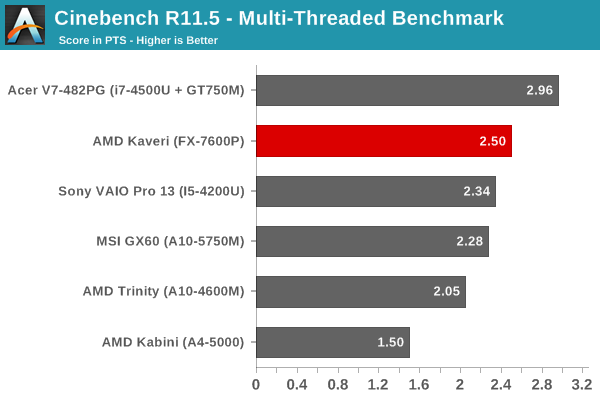
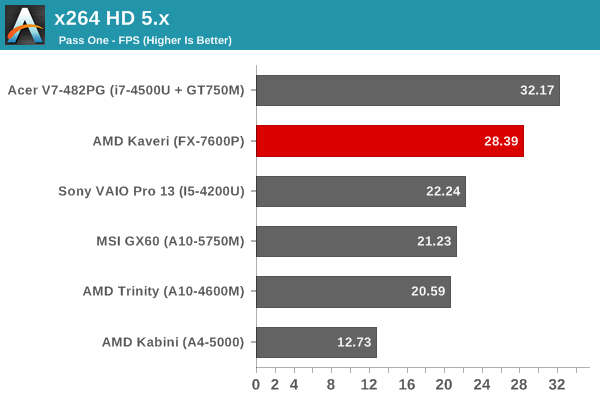
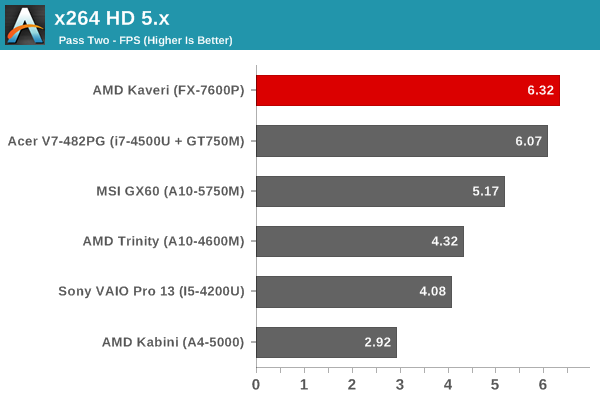
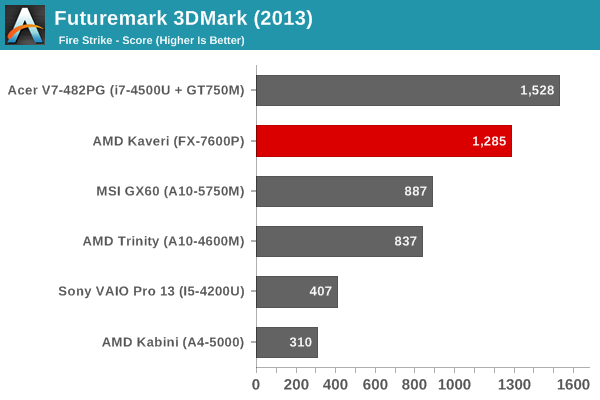
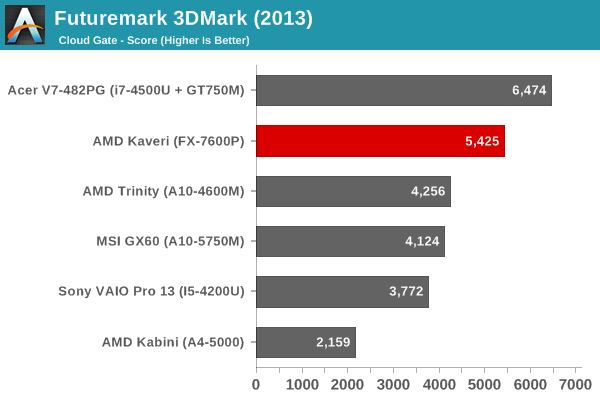

Somewhat surprisingly, Kaveri actually takes the lead in the very demanding second pass of the x264 HD 5.0 encoding test. Granted, we're looking at a 35W APU vs. 15W ULV CPU, and Intel's 37W quad-core parts would certainly retake the lead (and cost quite a bit more), but at least Kaveri is showing some real improvements over Richland in these tests. As noted above, PCMark 7 doesn't have any OpenCL optimizations so the gap between AMD and Intel is a bit wider.
Moving to the 3DMark results, Kaveri shows an impressive increase in performance over the Trinity/Richland GPU, which is expected. Intel's iGPU – particularly in the ULV system shown here – just doesn't stand a chance. While we are potentially TDP limited for the ULV Intel parts in graphics tests, my experience is that 3DMark hits the GPU much more than the CPU, so the GPU gets the lion's share of the TDP. I'll try to run some tests on other Haswell systems using the iGPU to verify the above results, but outside of the HD 5000 and Iris parts, I wouldn't expect Intel's iGPU to be too much faster than what we're seeing here.
Overall, an Intel CPU with a discrete GPU is still faster than Kaveri in most areas, and a quad-core i7-4702QM would really distance itself from AMD's Kaveri…but the quad-core i7 CPUs tend to start at around $350, so there's not much point in discussing that comparison. My personal feeling is that unless you're really pushing a laptop hard, most of the modern CPUs/APUs are plenty fast. I wouldn't want a Kabini APU, but Trinity/Richland, Ivy Bridge, Kaveri, and Haswell are all going to be fine for everyday use.
The more important element for me with a laptop (or desktop) is that I simply can't stand using conventional hard drives for the primary storage device any longer. Given the choice between an AMD Kaveri APU with a 256GB SSD (the Crucial MX100 is sure looking nice!) and pretty much any other laptop that has pure HDD storage, it's a no brainer for me. In fact, laptop manufacturers would do their customers a great service if they took the cost savings of AMD's APU vs. Intel's CPU and put that into a decent SSD solution rather than chasing the lowest possible price!


_thumb.jpg)
_thumb.jpg)
_thumb.jpg)
_thumb.jpg)
_thumb.jpg)








125 Comments
View All Comments
xenol - Wednesday, June 4, 2014 - link
TDP doesn't equal power consumption. It equals how much heat a cooling unit must dissipate for safe thermal levels of operation. While there is some correlation, as more TDP generally means higher power consumption, it's not a direct one.Galatian - Wednesday, June 4, 2014 - link
I think it actually pretty much does equal top power draw, since energy in pretty much equals heat out. But do correct me if I don't understand the physics correctly. To me it simply seems like no work being done.JarredWalton - Wednesday, June 4, 2014 - link
TDP means the maximum power that needs to be dissipated, but most CPUs/APUs are not going to be pushing max TDP all the time. My experience is that in CPU loads, Intel tends to be close to max TDP while AMD APUs often come in a bit lower, as the GPU has a lot of latent performance/power not being used. However, with AMD apparently focusing more on hitting higher Turbo Core clocks, that may no longer be the case -- at least on the 19W parts. Overall, for most users there won't be a sizable difference between a 15W Intel ULV and a 19W AMD ULV APU, particularly when we're discussing battery life. Neither part is likely to be anywhere near max TDP when unplugged (unless you're specifically trying to drain the battery as fast as possible -- or just running a 3D game I suppose).Galatian - Wednesday, June 4, 2014 - link
Yes, which is why I said it equal top power draw ;-)JarredWalton - Wednesday, June 4, 2014 - link
Yeah, my response was to this thread in general, not you specifically. :-)nevertell - Wednesday, June 4, 2014 - link
It's amazing that we live in a world where information is accessible on a whim to most people living in the western world, yet even on a website that caters to more educated people (or so I would think), people have problems understanding even the simplest concepts that enable them to expose themselves to this medium. Energy is never lost, it's just used up in different ways. Essentially if we had access to a superconductive material to replace lines and a really efficient transistor, we would have a SoC that's TDP is zero watts. Say, a chip does not move a thing, there is no mechanical energy involved, all of the energy is wasted as heat. Why ? Electricity at it's core is flow of charged particles through a medium. If this medium is copper and the particles are electrons, the only thing standing in the way of the electrons flowing are the copper atoms. The electrons will occasionally bump into the atoms, exchanging kinetic energy, making the atom in question move. As the atoms move faster (i.e. their kinetic energy increases), collisions become more likely to occur, and so they do. In other words, the conductors resistance increases. What scale do we use to measure the movement of atoms ? Temperature! Heat is literally the average amount of kinetic energy of every atom of piece of thing has. Thereby all of the energy that is used to power electronics just goes to waste. Kind of.ol1bit - Wednesday, June 4, 2014 - link
Unless you live in a cold climate, then you get to use part of the energy as Heat! :-)Galatian - Thursday, June 5, 2014 - link
I'm not sure who you are responding too. Nobody said energy is lost. The discussion was first about AMD TDP not being the same as Intel TDP and ten switched over to a discussion of TDP not actually meaning power draw, which by itself is true, but there obviously is a correlation which a several posters (yourself included with a more physical explanation) talked about .johnny_boy - Saturday, June 7, 2014 - link
Compare performance per watt in gaming and Intel stops looking impressive. If you're buying a notebook with the FX chip then that should be what you care about.bji - Wednesday, June 4, 2014 - link
The comparison is for CPUs in the same price range, not CPUs in the same TDP range, obviously.So the performance is decent for the price, as gdansk correctly pointed out. It is not decent for the TDP, at least not compared to Intel's chips, which is what you are focusing on, and is not the metric that most people use when comparing processors.